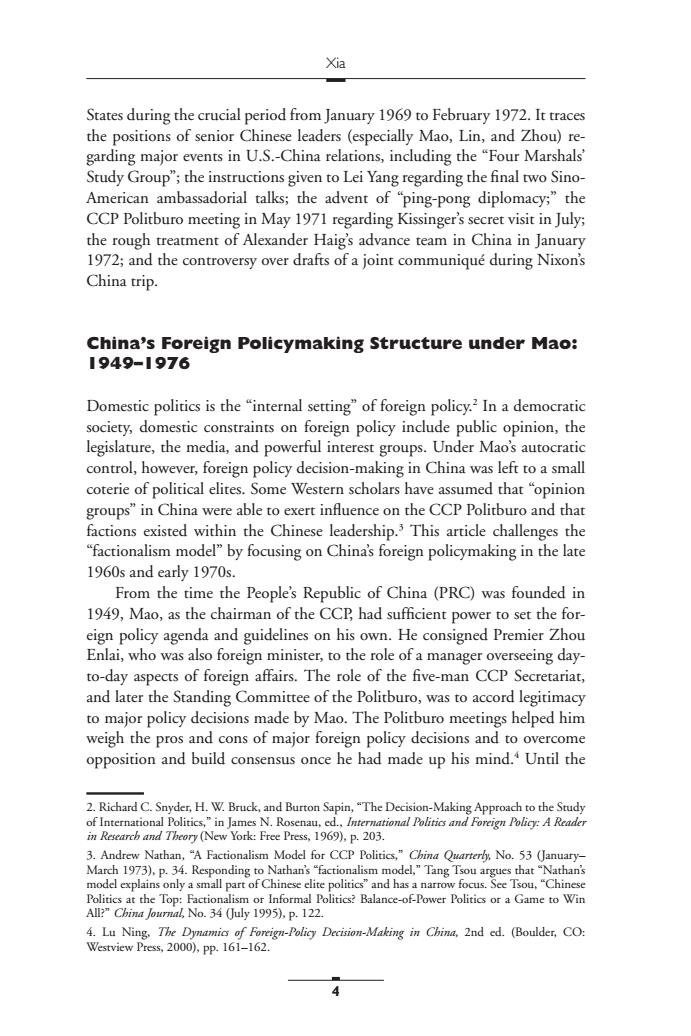正在加载图片...

Xia States during the crucial period from January 1969 to February 1972.It traces the positions of senior Chinese leaders(especially Mao,Lin,and Zhou)re- garding major events in U.S.-China relations,including the "Four Marshals Study Group";the instructions given to Lei Yang regarding the final two Sino- American ambassadorial talks;the advent of "ping-pong diplomacy;"the CCP Politburo meeting in May 1971 regarding Kissinger's secret visit in July; the rough treatment of Alexander Haig's advance team in China in January 1972;and the controversy over drafts of a joint communique during Nixon's China trip. China's Foreign Policymaking Structure under Mao: 1949-1976 Domestic politics is the"internal setting"of foreign policy.In a democratic society,domestic constraints on foreign policy include public opinion,the legislature,the media,and powerful interest groups.Under Mao's autocratic control,however,foreign policy decision-making in China was left to a small coterie of political elites.Some Western scholars have assumed that"opinion groups"in China were able to exert influence on the CCP Politburo and that factions existed within the Chinese leadership.This article challenges the "factionalism model"by focusing on China's foreign policymaking in the late 1960s and early 1970s. From the time the People's Republic of China(PRC)was founded in 1949,Mao,as the chairman of the CCP had sufficient power to set the for- eign policy agenda and guidelines on his own.He consigned Premier Zhou Enlai,who was also foreign minister,to the role of a manager overseeing day- to-day aspects of foreign affairs.The role of the five-man CCP Secretariat, and later the Standing Committee of the Politburo,was to accord legitimacy to major policy decisions made by Mao.The Politburo meetings helped him weigh the pros and cons of major foreign policy decisions and to overcome opposition and build consensus once he had made up his mind.Until the 2.Richard C.Snyder,H.W.Bruck,and Burton Sapin,"The Decision-Making Approach to the Study of International Politics,"in James N.Rosenau,ed.,International Politics and Foreign Policy:A Reader in Research and Theory (New York:Free Press,1969),p.203. 3.Andrew Nathan,"A Factionalism Model for CCP Politics,"China Quarterly,No.53 (January- March 1973),p.34.Responding to Nathan's"factionalism model,"Tang Tsou argues that"Nathan's model explains only a small part of Chinese elite politics"and has a narrow focus.See Tsou,"Chinese Politics at the Top:Factionalism or Informal Politics?Balance-of-Power Politics or a Game to Win All?"China Journal,No.34 (July 1995),p.122. 4.Lu Ning.The Dynamics of Foreign-Policy Decision-Making in China.2nd ed.(Boulder,CO: Westview Press,2000),pp.161-162.States during the crucial period from January 1969 to February 1972. It traces the positions of senior Chinese leaders (especially Mao, Lin, and Zhou) regarding major events in U.S.-China relations, including the “Four Marshals’ Study Group”; the instructions given to Lei Yang regarding the ªnal two SinoAmerican ambassadorial talks; the advent of “ping-pong diplomacy;” the CCP Politburo meeting in May 1971 regarding Kissinger’s secret visit in July; the rough treatment of Alexander Haig’s advance team in China in January 1972; and the controversy over drafts of a joint communiqué during Nixon’s China trip. China’s Foreign Policymaking Structure under Mao: 1949–1976 Domestic politics is the “internal setting” of foreign policy.2 In a democratic society, domestic constraints on foreign policy include public opinion, the legislature, the media, and powerful interest groups. Under Mao’s autocratic control, however, foreign policy decision-making in China was left to a small coterie of political elites. Some Western scholars have assumed that “opinion groups” in China were able to exert inºuence on the CCP Politburo and that factions existed within the Chinese leadership.3 This article challenges the “factionalism model” by focusing on China’s foreign policymaking in the late 1960s and early 1970s. From the time the People’s Republic of China (PRC) was founded in 1949, Mao, as the chairman of the CCP, had sufªcient power to set the foreign policy agenda and guidelines on his own. He consigned Premier Zhou Enlai, who was also foreign minister, to the role of a manager overseeing dayto-day aspects of foreign affairs. The role of the ªve-man CCP Secretariat, and later the Standing Committee of the Politburo, was to accord legitimacy to major policy decisions made by Mao. The Politburo meetings helped him weigh the pros and cons of major foreign policy decisions and to overcome opposition and build consensus once he had made up his mind.4 Until the 4 Xia 2. Richard C. Snyder, H. W. Bruck, and Burton Sapin, “The Decision-Making Approach to the Study of International Politics,” in James N. Rosenau, ed., International Politics and Foreign Policy: A Reader in Research and Theory (New York: Free Press, 1969), p. 203. 3. Andrew Nathan, “A Factionalism Model for CCP Politics,” China Quarterly, No. 53 (January– March 1973), p. 34. Responding to Nathan’s “factionalism model,” Tang Tsou argues that “Nathan’s model explains only a small part of Chinese elite politics” and has a narrow focus. See Tsou, “Chinese Politics at the Top: Factionalism or Informal Politics? Balance-of-Power Politics or a Game to Win All?” China Journal, No. 34 (July 1995), p. 122. 4. Lu Ning, The Dynamics of Foreign-Policy Decision-Making in China, 2nd ed. (Boulder, CO: Westview Press, 2000), pp. 161–162